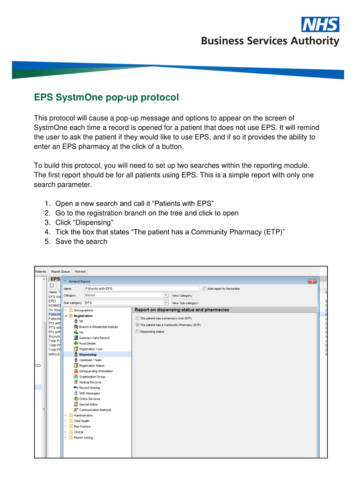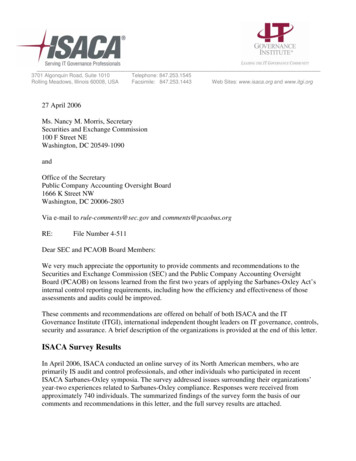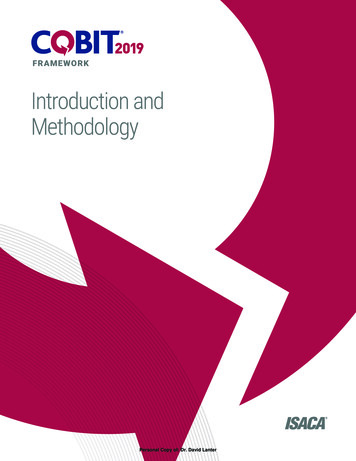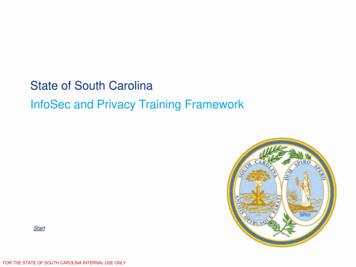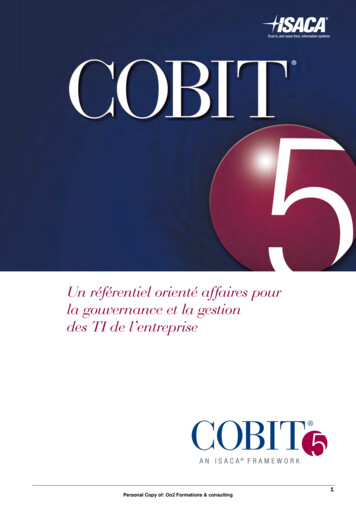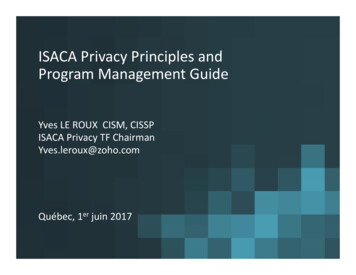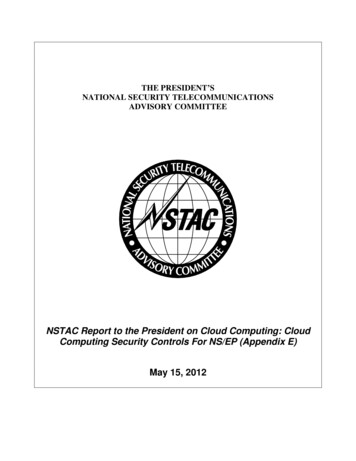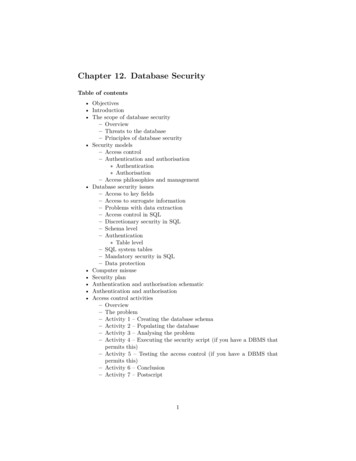
Transcription
Endpoint SecurityHidden Threats and a ProposedSolution to the ProblemISACA Fall Conference Sept 18th, 2007Better KnowledgeBetter DecisionsBetter SecuritySan Francisco ChapterThe Security Consortium
Who Am I? Mark S. Kadrich, CISSP– CEO of TSC I have an axe to grind so use appropriate filters– 25 years of security experience Practitioner, Customer, Vendor Electrical Engineer (this becomes relevant later)– Author Endpoint Security Published by Addison-Wesley ISBN 0-321-43695-4– Calls, complaints, compliments markkadrich@thesecurityconsortium.net 408-313-6263San Francisco Chapter2007 Fall Conference2
Agenda Problem StatementSome HistoryDifferences?ConclusionsPresent State of EPSSigns of Good EPSSan Francisco Chapter2007 Fall Conference3
Agenda Bad NewsA Proposed SolutionClosed Loop Process Control DefinedEndpoints DiscussedSome VendorsSome Questions for VendorsSan Francisco Chapter2007 Fall Conference4
Our Talk . There are systems on your network that you don't control. When didthe vending machines become a vector for a network attack? Whycan't I trust my printer? Besides the standard Windows, Mac, andLinux systems, I will discuss the security issues of various types ofsystems ranging from handhelds to embedded control systems.Virtually everything is getting a network connect these days andsometimes, many times, that's a bad thing. We will discuss whattype of controls are available and how a process control model canbe used to ensure system trust - and how some systems just can'tbe trusted. I will discuss how the endpoint and the network mustwork together to ensure compliance and security because bythemselves they are not capable of making an accuratedetermination.San Francisco Chapter2007 Fall Conference5
Problem Statement Controlled network growth difficult– Wireless helping here! Regulatory environment hostile– Lots of regulations– Lots of different interpretations Business processes drive architecture– (except for Microsoft)San Francisco Chapter2007 Fall Conference6
Problem Statement (more) Attacks are automated– Botnets are centrally managed– Smart malware tests multiple vectors Rootkits have “how to” books– You don’t have to be smart– Population of attackers increases Things happen really fastSan Francisco Chapter2007 Fall Conference7
Dead Man’s CurveReprovisioned vs Not Reprovisioned120Not ReprovisionedReprovisioned10010,000 Nodes20% Vulnerable80Percent60% of Throughput% Repaired Throughput40% of Systems Available% Repaired Sys Available200123456789 10 11 12 13 14 15 16 17 18 19 20-20ROI 2/secTTR 2 sec5K Payload-40Time in SecondsSan Francisco Chapter2007 Fall Conference8
Audit 101 Must have a policy to audit against Process must produce repeatable results Secure endpoints are:– Managed– Auditable– TrustworthySan Francisco Chapter2007 Fall Conference9
Some History fud Feds say things are getting better!– Never hear that in the media!– FBI/CSI report Anecdotal evidence says otherwiseHigh profile failuresScary Numbers /fud San Francisco Chapter2007 Fall Conference10
Why the Difference? Regulatory pressure– Changes reporting pressure– Must report some things now Reporting requirements makes more thingspublic– More things reported means that more action can betaken– More actions means improvement! Fiduciary responsibility– Forces legal group to manage survey responses– CSI/FBI had fewer details on financial lossSan Francisco Chapter2007 Fall Conference11
Conclusions Security continues to fail– That’s why we have numbers– That’s why they measure losses So – Original hypothesis is incorrect?– Method for gathering information is incorrect? How about both?San Francisco Chapter2007 Fall Conference12
Present State of EPS Independent products irusAntispywareSoftware updatesVulnerability managementIntrusion detectionIntrusion preventionUser provisioningPolicy managementAuthenticationAuthorizationSan Francisco Chapter2007 Fall Conference13
Present State of EPS That’s Okay, it’s only 11 or so consoles tomanage– Piece of cake, right? For the most part– None of them talk to each other– Configurations must be independently managed Vendors continue to– Generate new products– Provide no proof that they have secure productsSan Francisco Chapter2007 Fall Conference14
Present State of EPS Vendors worried about vulnerabilities– Eliminate all vulnerabilities and you’re secure!– Most VM solutions are Windows only Market Driven– Legislation (and thus audit) du jure– Lot’s of templates They’re easy Allow for OS hook Lots of Places that Leak– Printers– Embedded systems (More later)San Francisco Chapter2007 Fall Conference15
Present State of EPS Risk Management– Systems measured by state of patches– Also measured by vulnerability profile What apps are running Exchange, IIS, Apache are all vulnerabilities withsome nice features Instead of Risk, use Trust– Does system represent risk? (tough question)– But do you trust it enough to allow access? This is really the question you’re asking!San Francisco Chapter2007 Fall Conference16
Signs of Good EPS Centralized management– Good build, release, test, and update process– All systems comply with process– A way to track this exists Good policy– Covers all contingencies (like a good contract)– Doesn’t have to be worked around Trust based architecture– Decisions made regarding compliance– Do I trust this system enough to be on my network?San Francisco Chapter2007 Fall Conference17
More Signs of good EPS Basic blocking and tackling––––––AntivirusHIDSHost based firewallsAnti-spywareAnti-spamUser training Network Security Too!– Firewalls– NIDS/NIPS– NACSan Francisco Chapter2007 Fall Conference18
The Bad News Worse thing about the present state of EPS– It only focuses on things that you see or make thenews DesktopsNotebooksServersHandhelds Hidden things still out there– Embedded systems– Access Points– Printers (where are all your printers?)San Francisco Chapter2007 Fall Conference19
What Can Be Done? Need a better answer– Acknowledge lack of integrated engineering Driven by marketing Treading water– Integrate network and endpoints Both have strengths and weaknesses Overlap can be used to our advantage Identify the applicable processes– Many processes (human and technological)– Many disciplines (business and engineering)– Must be identified and accounted forSan Francisco Chapter2007 Fall Conference20
A Different Approach What is CLPC?– Closed Loop Process Control– A method of applying feedback such that a system (or process)becomes self regulating Why CLPC?– Needed to describe the science– Things happen too fast for humans to deal with– Things happen too slow for our unconnected technology toaddress Why CLPC applied to Networks– I was curious about our failures and our successes– Analyzed security technology from the perspective of a processcontrol engineer.San Francisco Chapter2007 Fall Conference21
How Does CLPC Work? Manages to a Set Point– Like the temperature in the house– In our case, a level of trust (compliance) Uses a proportional control as the foundation– Basic function that coarsely maintains setpoint– We’ll need to combine some things to make this work Uses Integral and Derivative controls to “home in” on setpoint– Integration sums errors (ex: failed logins)– Derivative monitors rate of change (ex: attack rate) All network devices must playSan Francisco Chapter2007 Fall Conference22
CLPC ExampleCondenserExpansionValveWindowsInsulationAir OutCompressorInner WallThermostatEvaporatorDoorOuter WallAir InHeaterDuctingSan Francisco Chapter2007 Fall Conference23
CLPC ExampleWater pressure can varywidely from street sourceValveFloatSource ValvePressure RegulatorSan Francisco Chapter1. SuccessCriteria wellunderstood2. Failure modesare wellunderstood3. Operates tosame levelevery time4. Self regulating2007 Fall Conference24
Analysis Devices categorized by their ability to addressproportional, derivative or integral control modes Some controls are “bang-bang”– Bimodal controls are either on or off– Function like thermostat There was not one proportional control!– Nothing that controlled the introduction of risk into thenetwork!– All endpoints treated with the same level of trust– Authorizations done strictly at user levelSan Francisco Chapter2007 Fall Conference25
Analysis ResultsToilets have a better proportional control thanour networks do.San Francisco Chapter2007 Fall Conference26
What’s Missing?A Basic proportional control that we canhang the rest of our control solutionsupon.San Francisco Chapter2007 Fall Conference27
How Does CLPC Work For Us? Setpoint is Minimum Compliance Level fornetwork you want access to Uses the network and the endpoint– Trust client on endpoint measures compliance,gathers authentication information– Trust client talks with NAC enabled architecture tocontrol access to network– Although user may be trusted, untrusted systemsaren’t given a chance to attack networkSan Francisco Chapter2007 Fall Conference28
CLPC Isn’t Just for Endpoints Governs all processes, for example– Device provisioning– Incident Response Some feedback, feed forward, and feedthrough paths are human based– Very low frequency– Very unreliable– Must be identified within the modelSan Francisco Chapter2007 Fall Conference29
Endpoints Defined––––WindowsLinuxMacHandhelds PDAs and Phones iPods (yep!)– Embedded Systems PrintersVending machinesControl systems (PLCs)Ipods (here too!)VoIP handsetsSan Francisco Chapter2007 Fall Conference30
Systems We Know Windows– Lots of security software for them– CLPC capable– Trust client available Require RFC-3580 compliant Devices– VLAN assignment capable– Can be broken Or, DHCP based solution– Not very strongSan Francisco Chapter2007 Fall Conference31
Systems We Know Mac– Enterprise manageable– Basic security tools available– CLPC capable (limited)– Again with the DHCP enforcement Linux– Lots of options (open vs commercial)– Basic security tools available– Not CLPC capableSan Francisco Chapter2007 Fall Conference32
More Systems Embedded devices–––––––Hidden from viewPrinters and APsMedical equipmentSCADA (PLC controllers)Commercial systems (dispensers)Transaction systemsNO UPDATE PROCESSES!San Francisco Chapter2007 Fall Conference33
Some Vendors Cisco, ConSentry, Elemental, Entarasys,Extreme, ForeScout, InfoExpress, Juniper,Lockdown, McAfee, Microsoft, Mirage,Nevis, StillSecure, Symantec, Vernier– However, complex and “feature rich”– Difficult to implement today– Some (many?) not designed (or tested) bysecurity people– Interoperability is not a consideration for mostSan Francisco Chapter2007 Fall Conference34
Questions–––––––What kind of independent testing have you done?What type of SDLC do you employ?Do you have a documented process?What software security testing tools do you use?How do you do flaw analysis?How are flaws incorporated back into the product?How many security engineers do you have working onthe product?– What industry certifications do your security engineerspossess?– What industry certifications does the product have?San Francisco Chapter2007 Fall Conference35
Thanks!Questions?Send them to:markkadrich@thesecurityconsortium.netOr call: 408-313-6263San Francisco Chapter2007 Fall Conference36
ISACA Fall Conference Sept 18th, 2007. San Francisco Chapter 2007 Fall Conference 2 Who Am I? Mark S. Kadrich, CISSP . - What industry certifications does the product have? San Francisco Chapter 2007 Fall Conference 36 Thanks! Questions? Send them to: markkadrich@thesecurityconsortium.net Or call: 408-313-6263.

